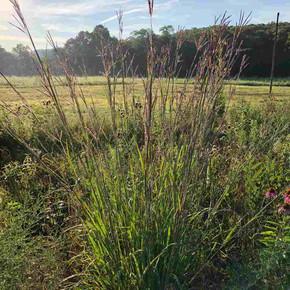
Andropogon gerardii 'Red October' - BIG BLUESTEM 'RED OCTOBER'
Andropogon ‘Red October's' leaves emerge green with reddish highlights. During the summer the plant changes to purplish-red to burgundy-purple. After first frost its leaves turn a vivid scarlet red.
Universal warm season grass that goes well with many perennials.
Blooming Time: August, flowers persist on the plant till winter (or until you cut it down in the spring), a bit slow to emerge in the spring (warm season grass)
Size: 5-6' tall x 2-3' wide
USDA Zones: 3 to 8
Culture: full sun, half sun (ideal is 6+ hours of direct sun or more). Adaptable to soil conditions, but avoid wet and waterlogged soils. Tolerant to heat, humidity, drought, air pollution and salt.
Moisture Needs: medium-moist to average (medium) to dry
Origin: Introduced by Brent Horvath from Intrinsic Perennial Garden, Hebron, Illinois. 'Red October' was discovered as a seedling of Andropogon gerardii 'Indian Warrior'. Patented plant under PP26283, unlicensed propagation is prohibited. The species (parent plant) are native grass to most of the USA, except the western states, see the USDA distribution map.
Deer/Rabbit Resistant: yes / yes
Attracts Butterflies or Pollinators: yes/yes
Attracts Hummingbirds: no, but beneficial to birds
Pot Size: square 3.5" x 4" deep perennial pot
Plant Combinations: For sunny flower beds, naturalistic gardens, prairies, meadows, for erosion control due to it's extensive root system. Can be planted as individual accent or in small groups as a gackground plant or in the middle of the bed.
Can be combined with native plants and their cultivars - choose Agastache, Amsonia, Asclepias, Asters, Baptisia, Coreopsis, Eryngium juccifolium, Echinacea, Gaura, Liatris, Penstemons, tall Phlox and hybrids, Yucca, or other native grasses like Boutelloa curtipendula, Sporobolus heterolepis, Panicum.
And non-native perennials like Achillea, summer blooming Allium, Aquilegia, Calamintha, Geranium, Gypsohila, Hemerocallis (daylily), Iris x barbata, Iris sibirica, Leucanthemum x superbum, Nepeta, Origanum, Paeonia, Perovskia, Platycodon, Salvia, tall Sedum, Sempervivum, Stachys,
Pictures Copyright: Mark Dwyer, Landscape Prescriptions by MD

Andropogon gerardii 'Red October' - BIG BLUESTEM 'RED OCTOBER'
Andropogon ‘Red October's' leaves emerge green with reddish highlights. During the summer the plant changes to purplish-red to burgundy-purple. After first frost its leaves turn a vivid scarlet red.
Universal warm season grass that goes well with many perennials.
Blooming Time: August, flowers persist on the plant till winter (or until you cut it down in the spring), a bit slow to emerge in the spring (warm season grass)
Size: 5-6' tall x 2-3' wide
USDA Zones: 3 to 8
Culture: full sun, half sun (ideal is 6+ hours of direct sun or more). Adaptable to soil conditions, but avoid wet and waterlogged soils. Tolerant to heat, humidity, drought, air pollution and salt.
Moisture Needs: medium-moist to average (medium) to dry
Origin: Introduced by Brent Horvath from Intrinsic Perennial Garden, Hebron, Illinois. 'Red October' was discovered as a seedling of Andropogon gerardii 'Indian Warrior'. Patented plant under PP26283, unlicensed propagation is prohibited. The species (parent plant) are native grass to most of the USA, except the western states, see the USDA distribution map.
Deer/Rabbit Resistant: yes / yes
Attracts Butterflies or Pollinators: yes/yes
Attracts Hummingbirds: no, but beneficial to birds
Pot Size: square 3.5" x 4" deep perennial pot
Plant Combinations: For sunny flower beds, naturalistic gardens, prairies, meadows, for erosion control due to it's extensive root system. Can be planted as individual accent or in small groups as a gackground plant or in the middle of the bed.
Can be combined with native plants and their cultivars - choose Agastache, Amsonia, Asclepias, Asters, Baptisia, Coreopsis, Eryngium juccifolium, Echinacea, Gaura, Liatris, Penstemons, tall Phlox and hybrids, Yucca, or other native grasses like Boutelloa curtipendula, Sporobolus heterolepis, Panicum.
And non-native perennials like Achillea, summer blooming Allium, Aquilegia, Calamintha, Geranium, Gypsohila, Hemerocallis (daylily), Iris x barbata, Iris sibirica, Leucanthemum x superbum, Nepeta, Origanum, Paeonia, Perovskia, Platycodon, Salvia, tall Sedum, Sempervivum, Stachys,
Pictures Copyright: Mark Dwyer, Landscape Prescriptions by MD









